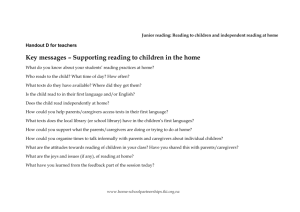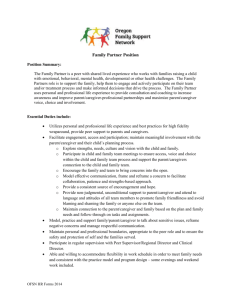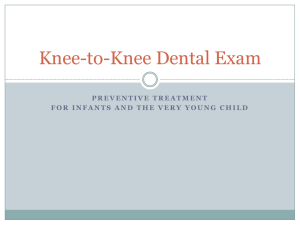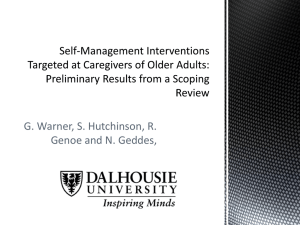FR 1-1 12/2011 Abstract Multiple Stakeholders Define Quality Child
advertisement
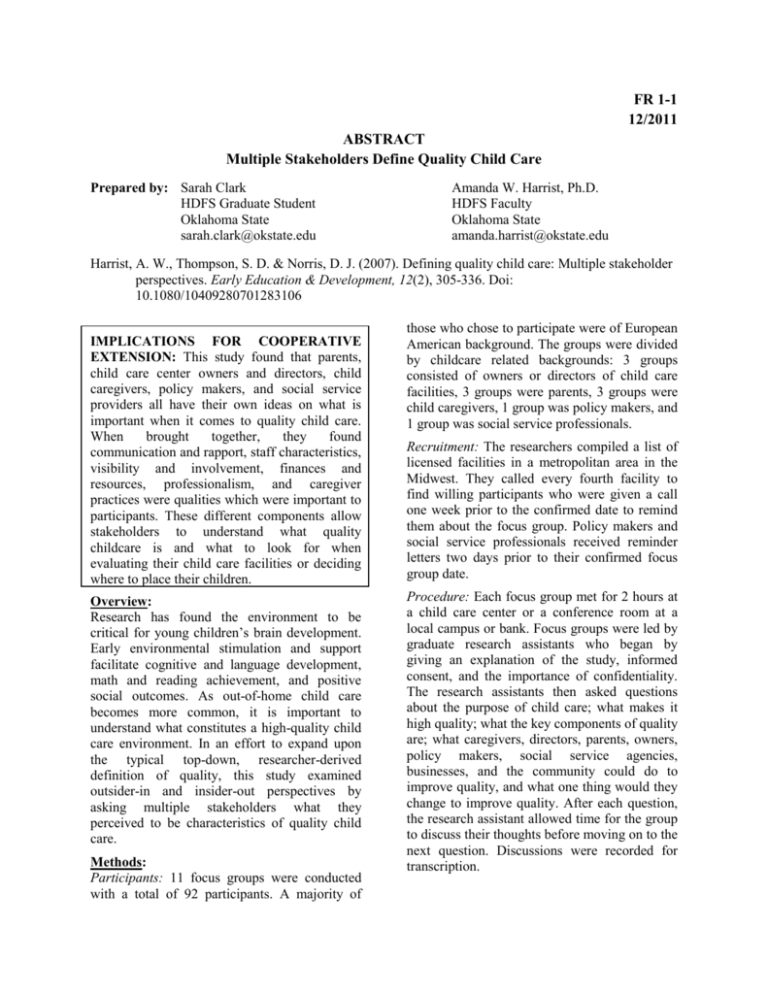
FR 1-1 12/2011 ABSTRACT Multiple Stakeholders Define Quality Child Care Prepared by: Sarah Clark HDFS Graduate Student Oklahoma State sarah.clark@okstate.edu Amanda W. Harrist, Ph.D. HDFS Faculty Oklahoma State amanda.harrist@okstate.edu Harrist, A. W., Thompson, S. D. & Norris, D. J. (2007). Defining quality child care: Multiple stakeholder perspectives. Early Education & Development, 12(2), 305-336. Doi: 10.1080/10409280701283106 IMPLICATIONS FOR COOPERATIVE EXTENSION: This study found that parents, child care center owners and directors, child caregivers, policy makers, and social service providers all have their own ideas on what is important when it comes to quality child care. When brought together, they found communication and rapport, staff characteristics, visibility and involvement, finances and resources, professionalism, and caregiver practices were qualities which were important to participants. These different components allow stakeholders to understand what quality childcare is and what to look for when evaluating their child care facilities or deciding where to place their children. Overview: Research has found the environment to be critical for young children’s brain development. Early environmental stimulation and support facilitate cognitive and language development, math and reading achievement, and positive social outcomes. As out-of-home child care becomes more common, it is important to understand what constitutes a high-quality child care environment. In an effort to expand upon the typical top-down, researcher-derived definition of quality, this study examined outsider-in and insider-out perspectives by asking multiple stakeholders what they perceived to be characteristics of quality child care. Methods: Participants: 11 focus groups were conducted with a total of 92 participants. A majority of those who chose to participate were of European American background. The groups were divided by childcare related backgrounds: 3 groups consisted of owners or directors of child care facilities, 3 groups were parents, 3 groups were child caregivers, 1 group was policy makers, and 1 group was social service professionals. Recruitment: The researchers compiled a list of licensed facilities in a metropolitan area in the Midwest. They called every fourth facility to find willing participants who were given a call one week prior to the confirmed date to remind them about the focus group. Policy makers and social service professionals received reminder letters two days prior to their confirmed focus group date. Procedure: Each focus group met for 2 hours at a child care center or a conference room at a local campus or bank. Focus groups were led by graduate research assistants who began by giving an explanation of the study, informed consent, and the importance of confidentiality. The research assistants then asked questions about the purpose of child care; what makes it high quality; what the key components of quality are; what caregivers, directors, parents, owners, policy makers, social service agencies, businesses, and the community could do to improve quality, and what one thing would they change to improve quality. After each question, the research assistant allowed time for the group to discuss their thoughts before moving on to the next question. Discussions were recorded for transcription. Results: Defining Components of Quality: Grounded theory analysis was conducted by three researchers and resulted in the identification of six categories which participants thought were important when looking for quality childcare. These categories were communication and rapport, staff characteristics, visibility and involvement, finances and resources, professionalism, and caregiver practices. Communication and rapport were seen as important because it allows for team work, improved accountability, and support and respect increase job satisfaction. Staff characteristics include child-to caregiver ratio, training and education of the caregiver, and turnover rate. These were seen as important because participants found those caregivers who are trained and educated are more likely to use developmentally appropriate practices in the classroom and be aware of children’s differences and needs. When there are lower child-to-caregiver ratios, the caregiver is able to focus more on individual children. A lower turnover rate allows for caregivers to know the children and parents, allows for consistency within the classroom, and helps establish rapport between the parents and caregivers. Visibility and involvement were differentially important, depending on the stakeholder involved: Parent visibility was seen as important because it allows for parent-caregiver relationships and encourages communication about how the child is doing outside the home setting. Director visibility was shows parents they know what is going on within the classrooms and facility. Owner visibility was seen as important because it allows for parents to know who the owners are as well as allowing the owners to observe the needs of the facility. Finances and resources were seen as important because as they were integrated with the other five quality components. Many felt child care cost needs to be reduced, but other noted that when costs are reduced, finances do not allow caregivers and directors to be paid what they need to support quality caregiving. Professionalism refers to caregiver and public perceptions of the profession of child care as valuable. Professionalism was seen as important because many in society do not deem early childhood education as important (as indicated by the low pay scale), yet research shows that it is quality care is crucial; until it is valued as a profession, it will be hard to make strides in improving pay or public policy. Caregiver practices include work habits, effective behaviors, and positive attitudes among child caregivers. They were seen as including developmentally appropriate practices, being nurturant and responsive to children, and maintaining safety guidelines. Participants felt caregivers should also be creative, parent-like, funloving, and expressive. These practices were seen as important because they allow for the caregiver to encourage the child’s development as well as give them a sense of security. Participants also felt caregivers need to continue with their education as well as learn through their experiences. Discussion: This study shows that diverse stakeholders such as parents, caregivers, directors, and policy makers agree there are certain components within child care settings that make them quality programs. Communication and rapport, staff characteristics, visibility and involvement, professionalism, and caregiver practices were all important to the desired quality of child care facilities but are hindered at times by finances, resources, and the lack thereof. By knowing what is considered central to quality in child care, those involved can help others become aware of the importance of early childhood education, which may then lead to policy makers understanding its importance, as well. The availability of quality child care will allow for families to place their children in facilities which will encourage the child’s socioemotional and cognitive development.



